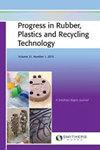热老化和汽车用油对电子束辐照丁苯橡胶/废橡胶和微波减硫化橡胶共混物性能的影响
IF 1.6
4区 材料科学
Q4 MATERIALS SCIENCE, COMPOSITES
Progress in Rubber Plastics and Recycling Technology
Pub Date : 2022-10-22
DOI:10.1177/14777606221136148
引用次数: 3
摘要
利用废聚合物替代原生聚合物已成为一种特殊的技术,引起了许多研究者和实业家的关注。在此背景下,本文讨论了用不同比例的废轮胎橡胶(WR)和微波硫化橡胶(DWR)部分替代原丁苯橡胶(SBR)在轮胎生产中的性能。首先加入固定比例的四甲基硫脲和纺锤油,然后将WR混合物暴露在不同的微波中。微波脱硫时间为6 min,脱硫率最高。制备的共混物在50和100 kGy的电子束加速器(EB)中暴露。对制备试样的FTIR、不同力学参数、热稳定性(TGA)和扫描电镜进行了分析。研究了车用油和不同温度(70℃和100℃)热老化对未辐照和辐照共混物拉伸强度和断裂伸长率的影响。热老化和油浸后的力学测量结果受影响最小。此外,这些因素在浸油和热老化前后的影响表明,未辐照和辐照的SBR/DWR共混物的性能优于SBR/WR。图形抽象本文章由计算机程序翻译,如有差异,请以英文原文为准。
Thermal aging and automotive oil effects on the performance of electron beam irradiated styrene butadiene rubber/waste and microwave devulcanized rubber blends
Replacement of virgin polymer with its waste become one of the special technique that capture the efforts of many researchers and industrialists alike. In this context, this work discussed the partial replacement of waste tire rubber (WR) and microwave devulcanized rubber (DWR) at different ratios on the properties of virgin styrene butadiene rubber (SBR) as one of the most essential components of synthetic rubber in the tire production. Fixed percent of tetramethylthiuram disulfide and spindle oil were added at the first, then the WR mixture was exposed to different microwave times. Microwave devulcanization value at time 6 min gave the highest devulcanization percent. The prepared blends were exposed in an electron beam accelerator (EB) at 50 and 100 kGy. FTIR, different mechanical parameters, thermal stability (TGA) and scanning electron microscopy of the fabricated specimens have been explained. Effect of automotive oil and thermal aging at different temperature, 70oC and 100oC on the tensile strength and elongation at break (E%) of the unirradiated and irradiated prepared blends have been estimated. Mechanical measurements of all examined specimens after thermal aging and oil immersion were least affected. Moreover, these factors before and after oil dipping and thermal aging revealed that unirradiated and irradiated SBR/DWR blends have superior properties than SBR/WR. Graphical Abstract
求助全文
通过发布文献求助,成功后即可免费获取论文全文。
去求助
来源期刊

Progress in Rubber Plastics and Recycling Technology
MATERIALS SCIENCE, COMPOSITES-POLYMER SCIENCE
CiteScore
4.40
自引率
7.70%
发文量
18
审稿时长
>12 weeks
期刊介绍:
The journal aims to bridge the gap between research and development and the practical and commercial applications of polymers in a wide range of uses. Current developments and likely future trends are reviewed across key areas of the polymer industry, together with existing and potential opportunities for the innovative use of plastic and rubber products.
 求助内容:
求助内容: 应助结果提醒方式:
应助结果提醒方式:


